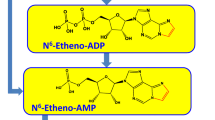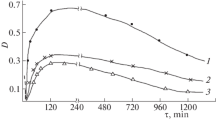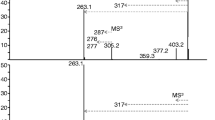Summary
In microsomes obtained from mouse pancreatic islets, the Mg complex of adenosine 5′-triphosphate (MgATP) increased the dissociation constant (K D) for binding of [3H]glibenclamide by sixfold. In the presence of Mg2+, not only ATP but also adenosine 5′-0-(3-thiotriphosphate) (ATPγS), adenosine 5′-diphosphate (ADP), guanosine 5′-triphosphate (GTP), guanosine 5′-diphosphate (GDP), guanosine 5′-0-(3-thiotriphosphate) (GTPγTS) and guanosine 5′-0-(2-thiodiphosphate) (GDPβ S) inhibited binding of [3H]glibenclamide. These effects were not observed in the absence of Mg2+. Half maximally effective concentrations of the Mg complexes of ATP, ADP, ATPγS and GDP were 11.6, 19.0, 62.3 and 90.1 μmol/l, respectively. The non-hydrolyzable analogues adenosine 5′-(β,γ-imidotriphosphate) (AMP-PNP) and guanosine 5′-(β,γ-imidotriphosphate) (GMP-PNP) did not alter [3H]glibenclamide binding in the presence of Mg2+. MgADP acted much more slowly than MgATP and both MgADP and MgADP did not inhibit [3H]glibenclamide binding when the concentrations of MgATP and MgATP were kept low by the hexokinase reaction. Development of MgATP-induced inhibition of [3H]glibenclamide binding and dissociation of [3H]-glibenclamide binding occurred at similar rates. However, the reversal of MgATP-induced inhibition of [3H]glibenclamide binding was slower than the association of [3H]glibenclamide with its binding site. Exogenous alkaline phosphatase accelerated the reversal of MgATP-induced inhibition of [3H]glibenclamide binding. MgATP enhanced displacement of [3H]glibenclamide binding by diazoxide. The data suggest that sulfonylureas and diazoxide exert their effects by interaction with the same binding site at the sulfonylurea receptor and that protein phosphorylation modulates the affinity of the receptor.
Similar content being viewed by others
References
Ashcroft FM (1988) Adenosine 5′-triphosphate-sensitive potassium channels. Ann Rev Neurosci 11:97–118
Cheng YC, Prusoff WH (1973) Relationship between the inhibition constant (K i) and the concentration of inhibitor which causes 50 per cent inhibition (I 50) of an enzymatic reaction. Biochem Pharmacol 22: 3099–3108
Corkey BE, Duszynski J, Rich TL, Matschinsky B, Williamson JR (1986) Regulation of free and bound magnesium in rat hepatocytes and isolated mitochondria. J Biol Chem 261:2567–2574
Dunne MJ (1989) Protein phosphorylation is required for diazoxide to open ATP-sensitive potassium channels in insulin (RINm5F) secreting cells. FEBS Lett 250:262–266
Findlay I, Dunne MJ (1986) ATP maintains ATP-inhibited K+ channels in an operational state. Pflügers Arch 407:238–240
Geisen K, Hitzel V, Okomonopoulos R, Punter J, Weyer R, Summ H-D (1985) Inhibition of [3]glibenclamide binding to sulfonylurea receptors by oral antidiabetics. Arzneimittelforschung 35:707–712
Gepts W, Christophe J, Mayer J (1960) Pancreatic islets in mice with the obese-hyperglycemic syndrome. Diabetes 9:63–69
Gilman AG (1987) G proteins: Transducers of receptor-generated signals. Ann Rev Biochem 56:615–649
Kozlowski RZ, Hales CN, Ashford MLJ (1989) Dual effects of diazoxide on ATP-K+ currents recorded from an insulin-secreting cell line. Br J Pharmacol 97:1039–1050
Lust WD, Feussner GK, Barbehenn EK, Passonneau JA (1981) The enzymatic measurement of adenine nucleotides and P-creatine in picomole amounts. Anal Biochem 110:258–266
Malaisse WJ, Sener A (1987) Glucose-induced changes in cytosolic ATP content in pancreatic islets. Biochim Biophys Acta 927:190–195
Martell AE, Smith RM (1974) Critical stability constants, vol 1 Amino acids, vol 2 Amines. Plenum, New York London
Mister S, Falke LC, Gillis K, McDaniel ML (1986) A metabolite-regulated potassium channel in rat pancreatic B cells. Proc Natl Acad Sci USA 83:7119–7123
Niki I, Kelly RP, Ashcroft SJH, Ashcroft FM (1989) ATP-sensitive K-channels in HIT T15 β-cells studied by patch-clamp methods, 86Rb efflux and glibenclamide binding. Pflügers Arch 415:47–55
Ohno-Shosaku T, Zünkler BJ, Trube G (1987) Dual effects of ATP on K+ currents of mouse pancreatic β-cells. Pflügers Arch 408:133–138
Otero AS (1990) Transphosphorylation and G protein activation. Biochem Pharmacol 39:1399–1404
Panten U, Burgfeld J, Goerke F, Rennicke M, Schwanstecher M, Wallasch A, Zünkler BJ, Lenzen S (1989) Control of insulin secretion by sulfonylureas, meglitinide and diazoxide in relation to their binding to the sulfonylurea receptor in pancreatic islets. Biochem Pharmacol 38:1217–1229
Panten U, Heipel C, Rosenberger F, Scheffer K, Zünkler BJ, Schwanstecher C (1990) Tolbutamide-sensitivity of the adenosine 5′-triphosphate-dependent K+ channel in mouse pancreatic B-cells. Naunyn-Schmiedeberg's Arch Pharmacol (in press)
Schwanstecher M, Rietze I (1990) Hydrolyzable nucleotides inhibit glibenclamide binding in pancreatic islets. Naunyn-Schmiedeberg's Arch Pharmacol 431 (Suppl):R72
Sturgess NC, Ashford MLJ, Cook DL, Hales CN (1985) The sulphonylurea receptor may be an ATP-sensitive K+ channel. Lancet 2:474–475
Trube G, Rorsman P, Ohno-Shosaku T (1986) Opposite effects of tolbutamide and diazoxide on the ATP-dependent K+ channel in mouse pancreatic β-cells. Pflügers Arch 407:493–499
Wallenstein S, Zucker CL, Fleiss JL (1980) Some statistical methods useful in circulation research. Circ Res 47:1–9
Williamson JR, Corkey BE (1969) Assays of intermediates of the citric acid cycle and related compounds by fluorometric enzyme methods. In: Lowenstein JM (ed) Methods in enzymology, vol 13. Academic Press, New York London, pp 440–445
Author information
Authors and Affiliations
Additional information
Some of the results described here are part of the medical theses of S. Löser and I. Rietze
Send offprint requests to M. Schwanstecher at the above address
Rights and permissions
About this article
Cite this article
Schwanstecher, M., Löser, S., Rietze, I. et al. Phosphate and thiophosphate group donating adenine and guanine nucleotides inhibit glibenclamide binding to membranes from pancreatic islets. Naunyn-Schmiedeberg's Arch Pharmacol 343, 83–89 (1991). https://doi.org/10.1007/BF00180681
Received:
Accepted:
Issue Date:
DOI: https://doi.org/10.1007/BF00180681




